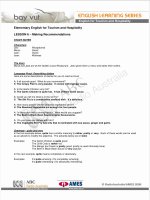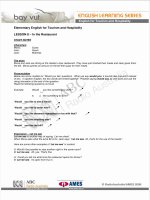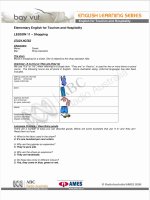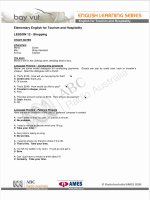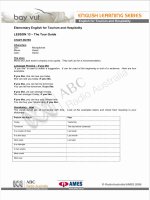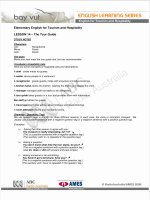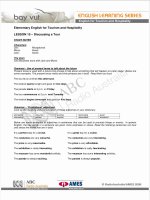english for road and bridge engineer tiếng anh kỹ thuật cho kỹ sư cầu đường
Bạn đang xem bản rút gọn của tài liệu. Xem và tải ngay bản đầy đủ của tài liệu tại đây (1.73 MB, 61 trang )
1
English for Road and Bridge Engineering
Unit 1: BRIDGE TYPES
A bridge is a structure built to span physical obstacles such as a body of water,
valley, or road, for the purpose of providing passage over the obstacle. Designs of
bridges vary depending on the function of the bridge, the nature of the terrain where
the bridge is constructed, the material used to make it and the funds available to
build it.
There are six main types of bridges: beam bridges, truss bridges, arch bridges,
cantilever bridges, suspension bridges and cable-stayed bridges.
Beam bridges
Beam bridges are horizontal beams supported at
each end by abutments, hence their structural name
of simply supported. When there is more than one
span the intermediate supports are known as piers. The earliest beam bridges were
simple logs that sat across streams and similar simple structures. In modern times,
beam bridges are large box steel girder bridges. Weight on top of the beam pushes
straight down on the abutments at either end of the bridge. They are made up mostly
of wood or metal. Beam bridges typically do not exceed 76 m long. The world's
longest beam bridge is Lake Pontchartrain Causeway in southern Louisiana in the
United States, at 38.35 km, with individual spans of 17 m.
Truss bridges
A truss bridge is a bridge composed of connected
elements (typically straight) which may be stressed
from tension, compression, or sometimes both in
response to dynamic loads. Truss bridges are one of the oldest types of modern
bridges. The basic types of truss bridges shown in this article have simple designs
which could be easily analyzed by nineteenth and early twentieth century engineers.
A truss bridge is economical to construct owing to its efficient use of materials.
Authors: Do Viet Hai – Phan Hoang Nam
2
English for Road and Bridge Engineering
Arch bridges
Arch bridges have abutments at each end. The
earliest known arch bridges were built by the
Greeks, and include the Arkadiko Bridge. The
weight of the bridge is thrust into the abutments at either side. Dubai in the United
Arab Emirates is currently building the Sheikh Rashid bin Saeed Crossing, which is
scheduled for completion in 2012. When completed, it will be the largest arch
bridge in the world.
Cantilever bridges
Cantilever bridges are built using cantilevers—
horizontal beams supported on only one end. Most
cantilever bridges use a pair of continuous spans that
extend from opposite sides of the supporting piers to meet at the center of the
obstacle the bridge crosses. Cantilever bridges are constructed using much the same
materials & techniques as beam bridges. The difference comes in the action of the
forces through the bridge. The largest cantilever bridge is the 549 m Quebec Bridge
in Quebec, Canada.
Suspension bridges
Suspension bridges are suspended from cables. The
earliest suspension bridges were made of ropes or
vines covered with pieces of bamboo. In modern
bridges, the cables hang from towers that are attached to caissons or cofferdams.
The caissons or cofferdams are implanted deep into the floor of a lake or river. The
longest suspension bridge in the world is the 3,909 m Akashi Kaikyo Bridge in
Japan.
Cable-stayed bridges
Cable-stayed bridges, like suspension bridges, are
held up by cables. However, in a cable-stayed
bridge, less cable is required and the towers holding
Authors: Do Viet Hai – Phan Hoang Nam
3
English for Road and Bridge Engineering
the cables are proportionately shorter. The first known cable-stayed bridge was
designed in 1784 by C.T. Loescher. The longest cable-stayed bridge is the Sutong
Bridge over the Yangtze River in China.
By use
A bridge is designed for trains, pedestrian or road traffic, a pipeline or waterway for
water transport or barge traffic. An aqueduct is a bridge that carries water,
resembling a viaduct, which is a bridge that connects points of equal height. A roadrail bridge carries both road and rail traffic.
Bridges are subject to unplanned uses as well. The areas underneath some bridges
have become makeshift shelters and homes to homeless people, and the undersides
of bridges all around the world are spots of prevalent graffiti. Some bridges attract
people attempting suicide, and become known as suicide bridges.
To create a beautiful image, some bridges are built much taller than necessary. This
type, often found in east-Asian style gardens, is called a Moon bridge, evoking a
rising full moon. Other garden bridges may cross only a dry bed of stream washed
pebbles, intended only to convey an impression of a stream. Often in palaces a
bridge will be built over an artificial waterway as symbolic of a passage to an
important place or state of mind. A set of five bridges cross a sinuous waterway in
an important courtyard of the Forbidden City in Beijing, the People's Republic of
China. The central bridge was reserved exclusively for the use of the Emperor,
Empress, and their attendants.
(Source: Wikipedia)
Authors: Do Viet Hai – Phan Hoang Nam
4
English for Road and Bridge Engineering
Match the words in column A with their meanings in column B.
A
B
a. In theory, the individual parts of this structure only
1. Beam bridge
subject to tension and compression forces but not
bending forces.
b. The second oldest bridge type. This structure doesn’t
2. Truss bridge
require piers in the center and uses a curved structure.
3. Arch bridge
c. The support is in the middle of a span, not the end.
4. Cantilever bridge
d. This structure is a continuous girder with one or more
towers erected above piers in the middle of the span.
5. Suspension bridge
e. This structure often uses I-beams or box girders in their
construction.
6. Cable-stayed bridge
f. This structure allows for the longest spans.
Word
Pronounced
beam
biːm
truss
trʌs
arch
ɑːtʃ
cantilever
ˈkæntɪliːvə(r)
suspension
səˈspenʃn
cable-stayed
ˈkeɪbl-steɪ
Authors: Do Viet Hai – Phan Hoang Nam
5
English for Road and Bridge Engineering
Vocabulary
Word
Pronounced
Meaning
span
spæn
the part of a bridge or an arch between one
vertical support and another
obstacle
ˈɒbstəkl
an object that is in your way and that makes it
difficult for you to move forward
terrain
təˈreɪn
used to refer to an area of land when you are
mentioning its natural features
material
məˈtɪəriəl
a substance that things can be made from
fund
fʌnd
money that is available to be spent
abutment
əˈbʌtmənt
stream
striːm
a masonry mass supporting and receiving the
thrust of part of an arch or vault
a continuous flow of liquid or gas
box steel girder
bɒks stiːl ˈɡɜːrdər
element
ˈelɪmənt
a necessary or typical part of something
tension
ˈtenʃn
the state of being stretched tight
compression
kəmˈpreʃn
an increase in pressure of the charge in an
engine or compressor obtained by reducing its
volume
dynamic load
daɪˈnæmɪk ləʊd
a force exerted by a moving body on a
resisting member, usually in a relatively short
time interval.
thrust
θrʌst
to push something/somebody suddenly or
violently in a particular direction
schedule
ˈʃedjuːl
a plan that lists all the work that you have to
do and when you must do each thing
continuous span
kənˈtɪnjuəs spæn
a span which is formed of a series of
consecutive spans (over three or more
supports) that are continuously or rigidly
connected so that bending moment may be
transmitted from one span to the adjacent ones
pier
pɪə(r)
a large strong piece of wood, metal or stone
that is used to support a roof, wall, bridge, etc.
Authors: Do Viet Hai – Phan Hoang Nam
6
English for Road and Bridge Engineering
suspend
səˈspend
to hang something from something else
cable
ˈkeɪbl
a set of wires, covered in plastic or rubber,
that carries electricity, telephone signals, etc
caisson
kəˈsuːn
a watertight chamber open at the bottom and
containing air under pressure, used to carry
out construction work under water
cofferdam
ˈkɒfəˌdæm
a watertight structure, usually of sheet piling,
that encloses an area under water, pumped dry
to enable construction work to be carried out.
tower
ˈtaʊə(r)
a tall narrow building or part of a building,
especially of a church or castle
train
treɪn
a railway/railroad engine pulling a number of
coaches/cars or trucks, taking people and
goods from one place to another
pedestrian
pəˈdestriən
a person walking in the street and not
travelling in a vehicle
road traffic
rəʊd ˈtræfɪk
a hard surface built for vehicles to travel on
pipeline
ˈpaɪplaɪn
a series of pipes that are usually underground
and are used for carrying oil, gas, etc. over
long distances
waterway
ˈwɔːtəweɪ
a river, canal, etc. along which boats can
travel
water transport
ˈwɔːtə(r) ˈtrænspɔːt
barge
bɑːdʒ
a large boat with a flat bottom, used for
carrying goods and people on canals and
rivers
aqueduct
ˈækwɪdʌkt
a structure for carrying water, usually one
built like a bridge across a valley or low
ground
road-rail bridge
rəʊd-reɪl brɪdʒ
makeshift shelter
ˈmeɪkʃɪft ˈʃeltə(r)
used temporarily for a particular purpose
because the real thing is not available
prevalent graffiti
ˈprevələnt ɡrəˈfiːti
Authors: Do Viet Hai – Phan Hoang Nam
7
English for Road and Bridge Engineering
suicide
ˈsuːɪsaɪd
dry bed
draɪ bed
convey
kənˈveɪ
the act of killing yourself deliberately
to make ideas, feelings, etc. known to
somebody
pebble
ˈpebl
a smooth, round stone that is found in or near
water
artificial
ˌɑːtɪˈfɪʃl
made or produced to copy something natural;
not real
exclusively
ɪkˈskluːsɪvli
only given to one particular person or group
attendant
əˈtendənt
a person whose job is to serve or help people
in a public place
Authors: Do Viet Hai – Phan Hoang Nam
8
English for Road and Bridge Engineering
Further reading
Golden Gate Bridge
The Golden Gate Bridge is a
suspension
bridge
spanning
the
Golden Gate, the opening of the San
Francisco
Bay into
the Pacific
Ocean. As part of both U.S. Route
101 and California State Route 1, the
structure links the city of San
Francisco on the northern tip of the
San Francisco Peninsula to Marin
County. The Golden Gate Bridge was the longest suspension bridge span in the world
when it was completed in 1937, and has become one of the most internationally
recognized symbols of San Francisco, California, and of the United States. Despite its
span length being surpassed by eight other bridges since its completion, it still has the
second longest suspension bridge main span in the United States, after the VerrazanoNarrows Bridge in New York City. It has been declared one of the modern Wonders of
the World by the American Society of Civil Engineers. The Frommers travel guide
considers the Golden Gate Bridge "possibly the most beautiful, certainly the most
photographed, bridge in the world".
(Source: Wikipedia)
Authors: Do Viet Hai – Phan Hoang Nam
9
English for Road and Bridge Engineering
Sutong Yangtze River Bridge
The Sutong Yangtze River Bridge
is a cable-stayed bridge that spans
the Yangtze River in China between
Nantong and Changshu, a satellite
city of Suzhou, in Jiangsu province.
With a span of 1,088 metres
(3,570 ft), it is the cable-stayed
bridge with the longest main span in
the world as of 2011. Its two side
spans are 300 metres (980 ft) each, and there are also four small cable spans. The
bridge received the 2010 Outstanding Civil Engineering Achievement award (OCEA)
from the American Society of Civil Engineers.
Two towers of the bridge are 306 metres (1,004 ft) high and thus the second tallest
in the world. The total bridge length is 8,206 metres (26,923 ft). Construction began in
June 2003, and the bridge was linked up in June 2007. The bridge was opened to
traffic on 25 May 2008 and was officially opened on 30 June 2008. Construction has
been estimated to cost about US$1.7 billion.
The completion of the bridge makes the commute between Shanghai and Nantong,
previously a four-hour ferry ride, shorten to about an hour. It brings Nantong one step
closer to becoming an important part of the Yangtze River Delta economic zone, and
has further attracted foreign investors into the city. The bridge is also pivotal in the
development of poorer northern Jiangsu regions.
(Source: Wikipedia)
Authors: Do Viet Hai – Phan Hoang Nam
1
English for Road and Bridge Engineering
Unit 2: BASIC BRIDGE TERMS
An important first step in understanding the principles and processes of bridge
construction is learning basic bridge terminology. Although bridges vary widely in
material and design, there are many components that are common to all bridges. In
general, these components may be classified either as parts of a bridge
superstructure or as parts of a bridge substructure.
SUPERSTRUCTURE
The superstructure consists of the components that actually span the obstacle the
bridge is intended to cross and includes the following:
1. Bridge deck
2. Structural members
3. Parapets (bridge railings), handrails, sidewalk, lighting and some drainage
features
The deck is the roadway portion of a bridge, including shoulders. Most bridge decks
are constructed as reinforced concrete slabs, but timber decks are occasionally used
in rural areas and open-grid steel decks are used in some movable bridge designs
(bascule bridge). As polymers and fiber technologies improve, Fiber Reinforced
Polymer (FRP) decks may be used.
Bridge decks are required to conform to the grade of the approach roadway so that
there is no bump or dip as a vehicle crosses onto or off of the bridge. The most
common causes of premature deck failure are:
1. Insufficient concrete strength from an improper mix design, too much water,
improper amounts of air entraining admixtures, segregation, or improper
curing.
2. Improper concrete placement, such as failure to consolidate the mix as the
concrete is placed, pouring the concrete so slowly that the concrete begins
the initial set, or not maintaining a placement rate.
Authors: Do Viet Hai – Phan Hoang Nam
2
English for Road and Bridge Engineering
3. Insufficient concrete cover due to improper screed settings or incorrect
installation of the deck forms and/or reinforcement.
A bridge deck is usually supported by structural members. The most common types
are:
1. Steel I-beams and girders
2. Precast, prestressed, reinforced concrete bulb T beams
3. Precast, prestressed, reinforced concrete I beams
4. Precast, prestressed, concrete box beams
5. Reinforced concrete slabs
Secondary members called diaphragms are used as cross-braces between the main
structural members and are also part of the superstructure. Parapets (bridge
railings), handrails, sidewalks, lighting, and drainage features have little to do with
the structural strength of a bridge, but are important aesthetic and safety items. The
materials and workmanship that go into the construction of these features require
the same inspection effort as any other phase of the work.
SUBSTRUCTURE
The substructure consists of all of the parts that support the superstructure. The
main components are abutments or end-bents, piers or interior bents, footings, and
piling.
Abutments support the extreme ends of the bridge and confine the approach
embankment, allowing the embankment to be built up to grade with the planned
bridge deck. Three typical abutment designs are illustrated in Figure 1.
Authors: Do Viet Hai – Phan Hoang Nam
3
English for Road and Bridge Engineering
Figure 1. Abutments
When a bridge is too long to be supported by abutments alone, piers or interior
bents are built to provide intermediate support. Although the terms may be used
interchangeably, a pier generally is built as a solid wall, while bents are usually
built with columns. Figure 1-2 illustrates several types of piers.
Authors: Do Viet Hai – Phan Hoang Nam
4
English for Road and Bridge Engineering
Figure 2. Piers
The top part of abutments, piers, and bents is called the cap. The structural members
rest on raised, pedestal-like areas on top of the cap called the bridge seats. The
devices that are used to connect the structural members to the bridge seats are called
shoes or bearings.
Abutments, bents, and piers are typically built on spread footings. Spread footings
are large blocks of reinforced concrete that provide a solid base for the substructure
and anchor the substructure against lateral movements. Footings also serve to
transmit loads borne by the substructure to the underlying foundation material.
When the soils beneath a footing are not capable of supporting the weight of the
structure above the soil, bearing failure occurs. The foundation shifts or sinks under
the load, causing structure movement and damage (Figure 3).
Authors: Do Viet Hai – Phan Hoang Nam
5
English for Road and Bridge Engineering
Figure 3. Soil Failure
In areas where bearing failure is likely, footings are built on foundation piling
(Figure 4). These load-bearing members are driven deep into the ground at footing
locations to stabilize the footing foundation. Piling transmits loads from the
substructure units down to underlying layers of soil or rock.
Figure 4. Structure Pilings
Authors: Do Viet Hai – Phan Hoang Nam
6
English for Road and Bridge Engineering
Fill in the blanks with proper terms in the box
wing walls
foundation
1.
pier flexibility
bridge bearings
solid abutments
open abutment
vehicle parapet
pier
bearing movements
for narrow bridges should only be adopted where the open
abutment solution is not possible. In the case of wide bridges the
solution is to be preferred, but there are many cases where economy must be the
overriding consideration.
2.
are devices for transferring loads and movements from the
deck to the substructure and foundations. In highway bridge
are
accommodated by the basic mechanisms of internal deformation (elastomeric),
sliding (PTFE), or rolling.
3.
as a safety barrier that is installed on the edge of a bridge or on
a retaining wall or similar structure where there is a vertical drop, and which
may contain additional protection and restraint for pedestrians and other road
users.
4. If the
has a bearing at its top, corresponding to a structural pin
joint, then the horizontal movements will impose moments at the base, their
magnitude will depend on the
5. Design the
to transfer and distribute the loads from the
structure to the ground. Ensure that the factor of safety against shear failure in
the soil is not reached and settlement is within the allowable limits.
6.
are essentially retaining walls adjacent to the abutment. The
walls can be independent or integral with the abutment wall.
Authors: Do Viet Hai – Phan Hoang Nam
7
English for Road and Bridge Engineering
Vocabulary
W ord
Pronounced
Meaning
terminology
ˌtɜːmɪˈnɒlədʒɪ
component
kəmˈpəʊnənt
superstructure
ˈsuːpəˌstrʌktʃə
substructure
ˈsʌbˌstrʌktʃə
bridge deck
brɪdʒ dɛk
parapet
ˈpærəpɪt, -ˌpɛt
handrail
ˈhændˌreɪl
sidewalk
saɪd wɔːk
lighting
laɪtɪŋ
drainage feature
ˈdreɪnɪdʒ ˈfiːtʃə
roadway portion
ˈrəʊdˌweɪ
reinforced concrete
ˌriːɪnˈfɔːs ˈkɒnkriːt
slab
slæb
timber deck
ˈtɪmbə dɛk
bascule bridge
ˈbæskjuːl dɛk
polymer
ˈpɒlɪmə
fiber
ˈfaɪbə
conform
kənˈfɔːm
bump
pʌmp
dip
dɪp
premature
ˌprɛməˈtjʊə, ˈprɛməˌtjʊə
failure
ˈfeɪljə
admixture
ədˈmɪkstʃə
segregation
ˌsɛɡrɪˈɡeɪʃən
consolidate
kənˈsɒlɪˌdeɪt
screed
skriːd
precast
ˌpriːkɑːst
prestressed
ˌpriːˈstrɛs
Authors: Do Viet Hai – Phan Hoang Nam
8
English for Road and Bridge Engineering
diaphragm
ˈdaɪəˌfræm
cross-brace
krɒs- breɪs
aesthetic
iːsˈθɛtɪk, ɪs-
workmanship
ˈwɜːkmənʃɪp
inspection
ɪnˈspɛkt
abutment (end-bent)
əˈbʌtmənt
pier (interior bent)
pɪə
footing
ˈfʊtɪŋ
piling
ˈpaɪlɪŋ
embankment
ɪmˈbæŋkmənt
cap
kæp
pedestal-like
ˈpɛdɪstəl
shoe (bearing)
ʃuː (ˈbɛərɪŋ)
spread footing
sprɛd ˈfʊtɪŋ
stabilize
ˈsteɪbɪˌlaɪz
Authors: Do Viet Hai – Phan Hoang Nam
9
English for Road and Bridge Engineering
Further reading
Spans and Span Length
The terms bridge and span are used interchangeable; however, to avoid confusion
and misunderstanding, Technicians and construction personnel draw a distinction
between the two.
A bridge is made up one or more spans. A span is a segment of a bridge that crosses
from one substructure unit to the next, from abutment to abutment, from abutment
to pier, from pier to pier, or from pier to abutment.
Span length refers to either the length of any individual span within the structure or
to the total bridge length. In most cases, span lengths are considered as the distance
between centerlines of bearing from one substructure unit to the next (Figure 5).
c
c
Center to center of bearing (c/c)
c
c
Center to center of bearing (c/c)
Figure 5. Bridge Spans
Authors: Do Viet Hai – Phan Hoang Nam
10
English for Road and Bridge Engineering
Simple and Continuous Spans
In addition to the basic bridge design (girder, arched, trussed, suspension, etc.), a
bridge may be further classified as a simple span, a continuous span, or a
combination simple, continuous span (Figure 6). The classification is based on the
arrangement of the bridge's structural members.
Simple Span
Two-Span Continuous Structure
Figure 6. Simple and Continuous Spans
A span with structural members that cross from one substructure unit to the next
substructure unit is a simple span. The simple span has fixed bearings on one end
and expansion bearings on the other end. Any bridge that is supported by abutments
alone is a simple span. An individual span within a bridge that extends from an
abutment to a pier or a pier to another pier is also a simple span. Occasionally
bridges are constructed as a series of simple spans.
A continuous span is a bridge or bridge segment with structural members that cross
over one or more substructure units without a break. The structural members may
have to be spliced to obtain the necessary length; however, they are still considered
one-piece members. Continuous spans are typically anchored to the substructure by
a number of expansion bearings and a single fixed bearing. Many bridges have both
simple and continuous spans.
Authors: Do Viet Hai – Phan Hoang Nam
1
English for Road and Bridge Engineering
Unit 3: BRIDGE CONSTRUCTION
Because each bridge is uniquely designed for a specific site and function, the
construction process also varies from one bridge to another. The process described
below represents the major steps in constructing a fairly typical reinforced concrete
bridge spanning a shallow river, with intermediate concrete column supports located
in the river.
Example sizes for many of the bridge components are included in the following
description as an aid to visualization. Some have been taken from suppliers'
brochures or industry standard specifications. Others are details of a freeway bridge
that was built across the Rio Grande in Albuquerque, New Mexico, in 1993. The
1,245-ft long, 10-lane wide bridge is supported by 88 columns. It contains 11,456
cubic yards of concrete in the structure and an additional 8,000 cubic yards in the
pavement. It also contains 6.2 million pounds of reinforcing steel.
Substructure
A cofferdam is constructed around each column location in the riverbed, and the
water is pumped from inside the enclosure. One method of setting the foundation is
to drill shafts through the riverbed, down to bedrock. As an auger brings soil up
from the shaft, a clay slurry is pumped into the hole to replace the soil and keep the
shaft from collapsing. When the proper depth is reached (e.g., about 80 ft or 24.4
m), a cylindrical cage of reinforcing steel (rebar) is lowered into the slurry-filled
shaft (e.g., 72 in or 2 m in diameter). Concrete is pumped to the bottom of the shaft.
As the shaft fills with concrete, the slurry is forced out of the top of the shaft, where
it is collected and cleaned so it can be reused. The aboveground portion of each
column can either be formed and cast in place, or be precast and lifted into place
and attached to the foundation.
Bridge abutments are prepared on the riverbank where the bridge end will rest. A
concrete backwall is formed and poured between the top of the bank and the
riverbed; this is a retaining wall for the soil beyond the end of the bridge. A ledge
(seat) for the bridge end to rest on is formed in the top of the backwall. Wingwalls
Authors: Do Viet Hai – Phan Hoang Nam
2
English for Road and Bridge Engineering
may also be needed, extending outward from the back-wall along the riverbank to
retain fill dirt for the bridge approaches.
Figure 1 Typical bored pile work process
1. Centering 2. Starting drilling 3. Inserting stand pipe 4.Feeding bentonite 5.Drilling till the
specified depth 6. Inserting belling bucket 7. Reaming bore hole bottom 8. Measuring depth
9. Setting up iron-reinforcement cage 10. Inserting tremie tube 11. Cleaning slime by an airlift 12. 13. Concreting 14. Completing cast-in-place concrete pile with belling bottom.
In this example, the bridge will rest on a pair of columns at each support point. The
substructure is completed by placing a cap (a reinforced concrete beam)
perpendicular to the direction of the bridge, reaching from the top of one column to
the top of its partner. In other designs, the bridge might rest on different support
configurations such as a bridge-wide rectangular pier or a single, T-shaped column.
Superstructure
4A crane is used to set steel or prestressed concrete girders between consecutive
sets of columns throughout the length of the bridge. The girders are bolted to the
column caps. For the Albuquerque freeway bridge, each girder is 6 ft (1.8 m) tall
and up to 130 ft (40 m) long, weighing as much as 54 tons.
Steel panels or precast concrete slabs are laid across the girders to form a solid
platform, completing the bridge superstructure. One manufacturer offers a 4.5 in
(11.43 cm) deep corrugated panel of heavy (7-or 9-gauge) steel, for example.
Authors: Do Viet Hai – Phan Hoang Nam
3
English for Road and Bridge Engineering
Another alternative is a stay-in-place steel form for the concrete deck that will be
poured later.
Figure 2 Steel girder bridge construction
Deck
A moisture barrier is placed atop the superstructure platform. Hot-applied polymermodified asphalt might be used, for example. A grid of reinforcing steel bars is
constructed atop the moisture barrier; this grid will subsequently be encased in a
concrete slab. The grid is three-dimensional, with a layer of rebar near the bottom of
the slab and another near the top.
Concrete pavement is poured. A thickness of 8-12 in (20.32-30.5 cm) of concrete
pavement is appropriate for a highway. If stay-in-place forms were used as the
superstructure platform, concrete is poured into them. If forms were not used, the
concrete can be applied with a slipform paving machine that spreads, consolidates,
and smooths the concrete in one continuous operation. In either case, a skidresistant texture is placed on the fresh concrete slab by manually or mechanically
scoring the surface with a brush or rough material like burlap. Lateral joints are
provided approximately every 15 ft (5 m) to discourage cracking of the pavement;
these are either added to the forms before pouring concrete or cut after a slipformed
slab has hardened. A flexible sealant is used to seal the joint.
Authors: Do Viet Hai – Phan Hoang Nam
4
English for Road and Bridge Engineering
Vocabulary
Word
Pronounced
site
saɪt
function
ˈfʌŋkʃən
shallow river
ˈʃæləʊ
aid
ˈrɪvə
visualization
ˌvɪʒʊəlaɪˈzeɪʃən
supplier
səˈplaɪə
brochure
ˈbrəʊʃjʊə, -ʃə
standard specification
ˈstændəd ˌspɛsɪfɪˈkeɪʃən
Freeway
ˈfriːˌweɪ
pavement
ˈpeɪvmənt
Riverbed
ˈrɪvəbed
Enclosure
ɪnˈkləʊʒə
shaft
ʃɑːft
bedrock
ˈbɛdˌrɒk
auger
ˈɔːɡə
clay slurry
kleɪ ˈslʌrɪ
cylindrical cage of reinforcing steel
sɪˈlɪndrɪkəl keɪdʒ
cast in place
kɑːst ɪn pleɪs
Precast
priːˈ kɑːst
riverbank
ˈrɪvə bæŋk
ledge seat
lɛdʒ
configuration
kənˌfɪɡjʊˈreɪʃən
prestressed concrete
priˈstrest ˈkɒnkriːt
precast concrete slab
priːˈ kɑːst ˈkɒnkriːt slæb
laid
leɪd
platform
ˈplætfɔːm
corrugated panel
ˈkɔrəgeit ˈpænəl
stay-in-place steel form
steɪ in pleɪs stiːl fɔːm
Meaning
Authors: Do Viet Hai – Phan Hoang Nam
5
English for Road and Bridge Engineering
moisture barrier
ˈmɔɪstʃə ˈbærɪə
rebar
ˈriːbɑː
skid-resistant
skɪd rɪˈzɪstənt
rough
rʌf
burlap
ˈbɜːlæp
discourage
dɪˈsˈkʌrɪdʒ
sealant
ˈsiːlənt
seal
siːl
Authors: Do Viet Hai – Phan Hoang Nam
6
English for Road and Bridge Engineering
Further reading
Quality Control
The design and construction of a bridge must meet standards developed by several
agencies including the American Association of State Highway and Transportation
Officials, the American Society for Testing and Materials, and the American
Concrete Institute. Various materials (e.g., concrete batches) and structural
components (e.g., beams and connections) are tested as construction proceeds. As a
further example, on the Albuquerque bridge project, static and dynamic strength
tests were conducted on a sample column foundation that was constructed at the
site, and on two of the production shafts.
The Future
Numerous government agencies and industry associations sponsor and conduct
research to improve materials and construction techniques. A major goal is the
development of lighter, stronger, more durable materials such as reformulated, highperformance concrete; fiber-reinforced, polymer composite materials to replace
concrete for some components; epoxy coatings and electro-chemical protection
systems to prevent corrosion of steel rebar; alternative synthetic reinforcing fibers;
and faster, more accurate testing techniques.
Authors: Do Viet Hai – Phan Hoang Nam
